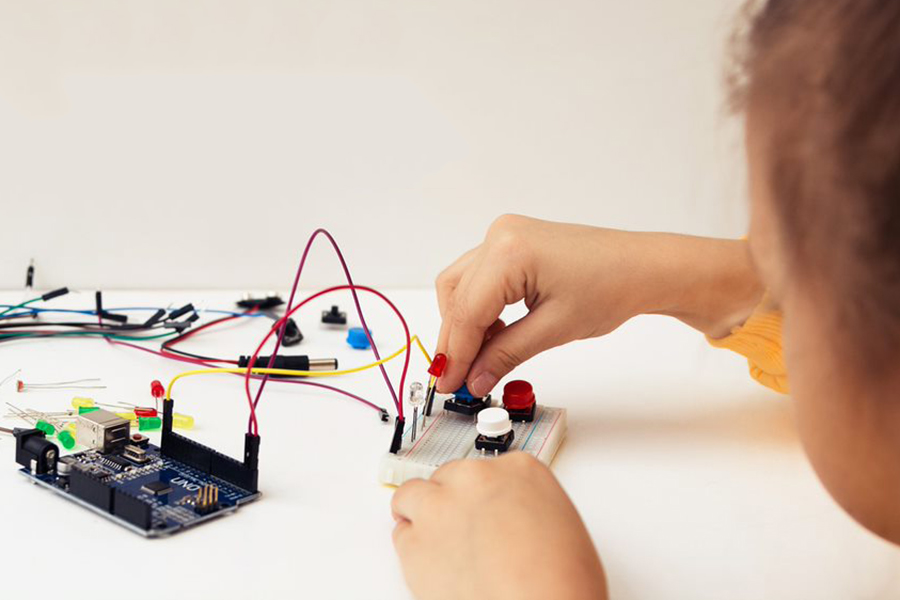Bridging the STEM Gap: 5 Things Parents Can Do
06/3/19

There is no doubt about the gender imbalance in STEM. Women are unrepresented in the science and technology occupations, and this divide only keeps growing. Currently, only around a quarter of all workers in STEM are women, yet in some nations like the UK, this number is even lower.
This difference is known as the STEM gap, and bridging the STEM gap is only becoming increasingly important as our society advances. STEM fields are in need of more specialists, and it’s more than obvious that we need more females to be involved in STEM.
Bridging the STEM Gap Starts at Home
It turns out that the STEM gap forms early in childhood and much earlier that we may be aware of it. Sources indicate that as early as of the age of 7 children will have already assimilated the idea of gender differences.
This means that bridging the STEM gap should start early as well. While teachers can absolutely play an important role in doing so, the most influence during this tender age comes from home. Which is why, parents need to be constantly aware of how their words, actions, and choices are shaping their daughters’ future.
So, how can you, as a parent start bridging the STEM gap? Let’s take a look at a few relatively simple ways you can start doing that today.
5 Ways Parents Can Bridge the STEM Gap at Home
1. Expose Girls to Female Role Models
One of the main reasons why there is a lack of women in STEM is because girls and women believe that STEM is for men. If we primarily see men in STEM, we start assuming that STEM is for men and women have no place in science, technology, and computing. That’s absolutely not true.
While men are slightly more apt in visual-spacial intelligence, the difference is so minimal that it’s not enough to prevent women from succeeding in STEM. There absolutely have been important women in STEM. The real question is whether our girls know about them.
So, take an inventory of what books your daughter has at home and what cartoons she’s watching.
Are they about princesses who are concerned about looking pretty and are waiting to be saved? Do they feature intelligent science-oriented boys like Dexter and silly girls who constantly mess up and get into trouble like his sister Dee Dee?
They are not just books or cartoons. They are sources of information that teach our children how the world operates.
To bridge the STEM gap, choose books and cartoons that show smart and independent girls. Pixar has been making an effort in creating more powerful female protagonists, and there are books like Good Night Stories for Rebel Girls that focus on women who’ve accomplished something significant in their lives.
2. Encourage
A recent study by Microsoft concluded that encouragement from teachers and parents can make a massive difference in bridging the STEM gap. Results showed that girls who received encouragement were on average twice more likely to take computer and science courses in high school and enroll in science degrees in college.
When it comes to parents, this encouragement should come not only from moms but also from dads. Since many view STEM subjects as primarily male, words of encouragement from dads are equivalent to saying: “Hey, science is for you too.”
3. Provide Hands-on Experience
Talking isn’t enough. Parents also need to make sure that girls get a chance to have hands-on experience with STEM subjects. About 72% of girls indicate their willingness to work jobs that make a difference and 90% of girls identify as creative. Meanwhile, they see STEM subjects as pointless and boring.
Hands-on experience cannot only make STEM skills seem less foreign and intimidating but also demonstrate that they can have real-life application. At home, this can be the choice of toys.
Therefore, instead of only buying gender-specific and girl-oriented toys, opt for toys that stores would label as toys for boys. These can be science kits, explorer games, building blocks, puzzles, logic games, and more.
That being said, don’t shy away from girl toys either. Make sure to provide girls with a variety of toys and giving them choices and options.
4. Consider Extracurricular STEM Activities
An excellent way of bridging the STEM gap early and providing girls with hands-on experience is enrolling them in extracurricular STEM classes. Sometimes, schools may have those, but you can also look for a local STEM learning center. These activities not only let girls have real-life experience with STEM skills, but also teach about their importance in the future of jobs.
The Microsoft study concluded that middle school girls who took part in extracurricular STEM programs were 2-3 times more likely to study physics, engineering, and computer science.
5. Teach Girls to Be Comfortable with Failure
STEM fields require one to be comfortable with failure. Imagine developing new medication, a computer program, or any other innovative product. The process before launching it will involve developing prototypes, identifying errors, and testing.
None of that can be successful if the people working on it aren’t comfortable with failure.
However, studies have concluded what women fear failure more than men and often do not apply for jobs unless they feel 100% confident. Moreover, women are judged for failing harsher whereas men are more likely to just push through.
All of that combines does not make STEM a favorable environment to thrive.
Unless, of course, we teach girls from a young age that failure is not only OK but absolutely necessary for learning and innovation. Therefore, next time your daughter does not succeed in something, make sure to encourage her to try once more.
Do you think bridging the STEM gap would be possible if parents applied these techniques? We’d love to hear your take on it? Perhaps, you have more suggestions? Connect with us on Facebook, Instagram, and Twitter and share those with us!